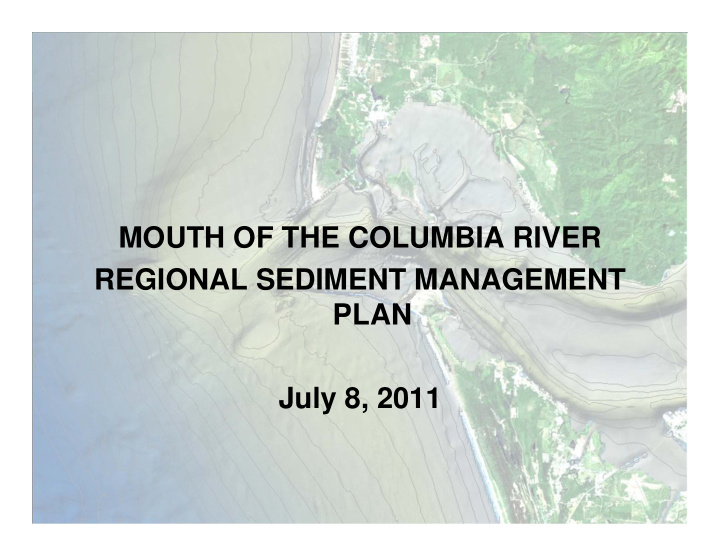



MOUTH OF THE COLUMBIA RIVER REGIONAL SEDIMENT MANAGEMENT PLAN July 8, 2011
SUMMARY OF PROCESS • Science-Policy workshops convened by LCSG in 2005, 2007, 2009 and 2010 • Since 2002, more than dozen different research projects, including sand tracer studies • Columbia Nearshore Beneficial Use Project initiated in 2004 • Southwest Washington Littoral Drift Restoration Project initiated in 2007 • Demonstration projects within the OR nearshore and on-shore at Benson Beach • Collaborative projects, e.g. navigational aid projects (enhancements to ARGUS beach monitoring; CDIP wave-ride buoy)
= South Jetty Site Tracer Study Area South Jetty Site Tracer Study Area Figure 1
SUMMARY OF PROCESS, cont. RSMP process initiated by LCSG in 2010 • Steering Group and SAT established • August 2010 Policy workshop • November 2010 Science/Policy workshop • Interviews with key stakeholders • February 2011 Preliminary Review Draft Plan • March 2011 Targeted Outreach session • June 2011 Public Review Draft Plan
Peacock ? Spit ? SWS Clatsop Spit CAN WE ? : * Reduce the rate of erosion affecting the jetties? * Reduce shoreline erosion along areas north and south of MCR?
RSMP Provide long-term strategy to guide sediment management at MCR, serve as basis for permitting a network of beneficial use sites, and facilitate securing of appropriations to finance ongoing R & M Material placed at DWS is lost to littoral system Status quo is unacceptable -- ongoing erosion, potential breaching of jetties, increasing deterioration of nearshore environment Need for a regional approach
PLAN ELEMENTS • Assumptions and Conditions • Network of Sites • Adaptive Management Program • Management and Implementation
Assumptions and Conditions • “Clean” resource of fine sediments. • The network of existing disposal sites needs to be expanded to include beneficial use sites that can be sustainably and adaptively managed to add clean sediment to the littoral system. • Thin-layer disposal at new beneficial use sites would be expected to have less impact on navigational safety and biological resources than continuing disposal at the currently authorized sites. • Nothing precludes the identification of additional sites as potential disposal locations. • Disposal is limited to MCR sediment and to disposal by the Corps. • Current disposal practices and erosion patterns have their own sets of effects on environmental resources and navigation safety.
Assumptions and Conditions • Planning for new disposal sites is recognized as an exercise in risk management; thus, an adaptive approach is needed. • While data gaps continue to be filled, there is a considerable amount known about the area and a valid basis for expectations about the levels of potential risks to the physical and biological environments. • A minimum amount of sand needs to be provided annually in order to demonstrably help sustain jetties, beaches, and marine habitat.
Network of Sites System of 7 sites • Existing Authorized Sites – SWS, NJS, DWS • New Beneficial Use Sites -- 2 nearshore = South Jetty, North Head -- 2 on-shore = Clatsop spit, Benson Beach • Guidelines for prioritization; function of AMT • DWS should only be employed when weather or other factors eliminate nearshore or on-shore options.
Adaptive Management Program Adaptive Management Team Annual Use Plan Research and Monitoring Management and Implementation
Adaptive Management Team • Appointed/convened by LCSG • Representatives from federal, state and local regulatory agencies; CRCFA; academic community • Management and technical teams • Functions -- Develop recommended program of baseline studies and R & M -- Monitor the disposal program and recommends adjustments as needed
Adaptive Management Team • Functions, cont. -- Develop protocols for determining if beneficial or adverse effects have been realized, and design and evaluate options for how to proceed if adverse effects occur. -- Identify minimum thresholds for the amounts of sand disposed of at each site needed to provide for the efficacy of monitoring. -- Recommend priority locations for disposal -- Identify funds and/or other commitments to help implement the proposed R&M priorities.
Annual Use Plan • Describes the timing, methods of disposal and monitoring for each site, including priorities for site use and disposal methods • Developed by Corps, approved by EPA
Research & Monitoring Program Navigational Safety • Continuation of bathymetric monitoring • Wave height threshold of 10% increase • Predictive & real-time information on waves and wind
Research & Monitoring Program Biological Sciences • Focused on species of concern -- Dungeness crab -- Razor clams -- Other fish species • Baseline surveys and pre- and post- disposal monitoring • South Jetty area as a priority
Management and Implementation • Regional initiative led by LCSG • Element of 2005 SMMP that governs Lower Columbia River dredging and disposal • Disposal at new beneficial use sites conducted under Corps authority • Initial steps -- Establishing and convening of AMT -- Securing funding for baseline studies and R & M program
Management and Implementation • Summer 2011 Develop cooperative agreements for Plan implementation and funding. • Summer/Fall 2011 Establish and convene AMT to design baseline studies and initial R&M • Summer 2012 Conduct baseline studies. • August 2012 Initiate disposal within network of beneficial use sites. • September 2012- Conduct post-disposal monitoring. Summer 2013 • Winter 2013 AMT reviews data from 2012 and develops any recommended modifications to disposal or monitoring program for incorporation into 2013 Annual Use Plan.
Recommend
More recommend